If you’re looking for a vibrant addition to your aquarium, look no further than the cardinal tetra. These small, brightly colored fish are a popular choice for many aquarium enthusiasts due to their stunning appearance and peaceful nature. However, caring for cardinal tetras requires a bit of knowledge and attention to detail to ensure they thrive in their aquatic environment.
Cardinal tetras require a well-maintained aquarium with suitable water conditions, a varied diet, and a peaceful environment. They need a pH range of 4.6-6.2 and a temperature range between 75-82°F. The aquarium should be planted, and regular water changes should be performed to ensure their health.
In this ultimate care guide, I’ll be sharing everything you need to know about keeping your cardinal tetras healthy and happy. From setting up the perfect tank to feeding and maintaining water quality, we’ll cover it all. Whether you’re a seasoned fish keeper or a newbie to the hobby, this guide will provide you with the knowledge and skills to care for your cardinal tetras with confidence.
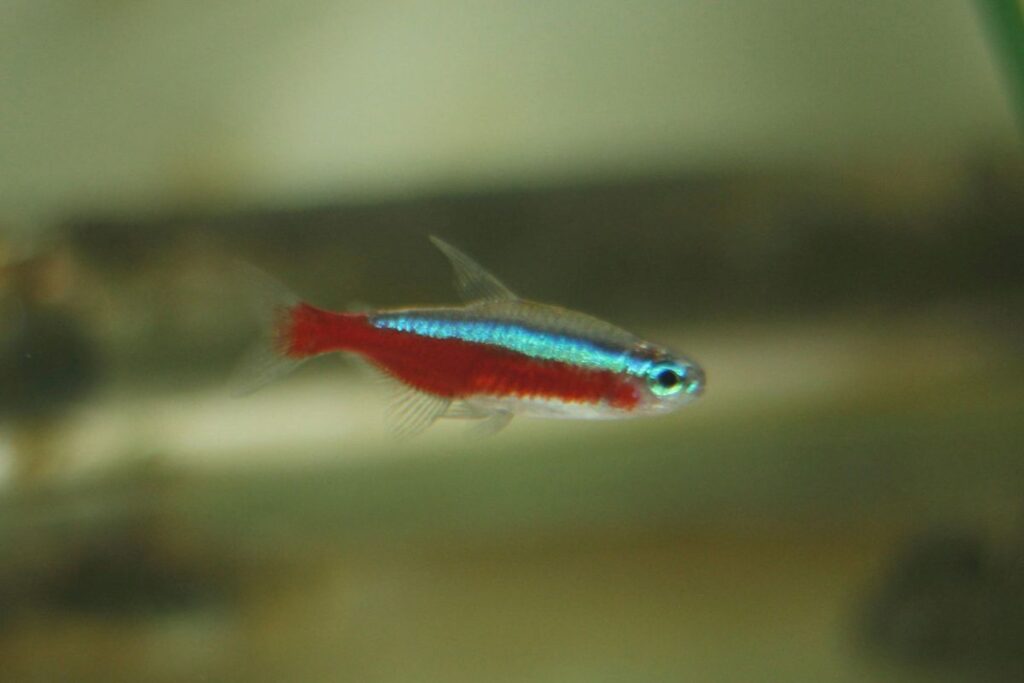
Table of Contents
Species Summary
Origin
The Cardinal Tetra is a small freshwater fish that is native to the Amazon Basin in South America. They are found in slow-moving rivers, streams, and flooded forests.
The first Cardinal Tetras were exported from Brazil in the 1930s, and they have since become a popular aquarium fish all over the world.
Appearance
The Cardinal Tetra is a stunning fish with bright, iridescent blue and red stripes that run the length of its body. The blue stripe starts at the nose and runs through the eye to the base of the tail.
The red stripe starts at the middle of the body and runs to the base of the tail.
The Cardinal Tetra has a short, rounded body and a forked tail. They are small, growing to only about 1.5 inches in length.
Size
Cardinal Tetras are small fish, growing to only about 1.5 inches in length. They are best kept in groups of at least six, so a tank of at least 10 gallons is recommended.
Lifespan
The average lifespan of a Cardinal Tetra is around 2-3 years, although with proper care, they can live up to 5 years.
Growth Rate
The growth rate of Cardinal Tetras is relatively slow, and they may take up to a year to reach their full size. It’s important to provide them with a nutritious diet and clean water to promote healthy growth.
Behavior & Temperament
Cardinal Tetras are peaceful fish that do well in community tanks with other small, non-aggressive fish. They are active swimmers and prefer a planted tank with plenty of hiding places.
They are known to shoal, so keeping them in groups of at least six is recommended.
I have found that my Cardinal Tetras are particularly active and playful during feeding times, and they often chase each other around the tank.
Overall, Cardinal Tetras are a beautiful and fascinating fish that can make a great addition to any aquarium. With proper care and attention, they can thrive and bring joy to their owners for years to come.
Neon Tetra vs Cardinal Tetra
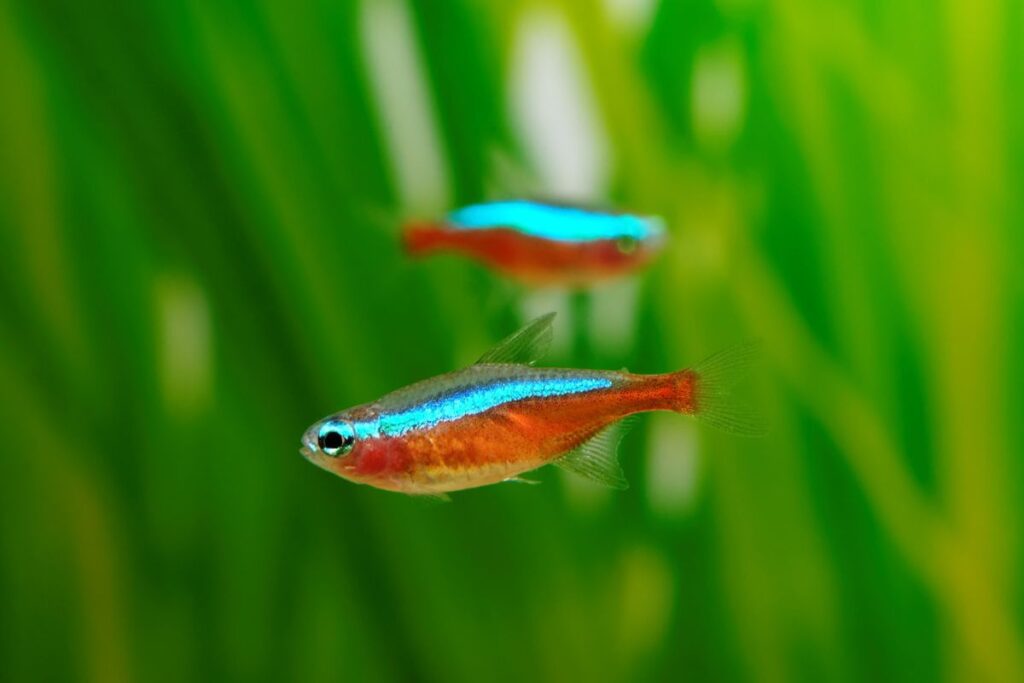
When it comes to small, colorful fish, neon tetras and cardinal tetras are two of the most popular choices for aquarium enthusiasts.
While they may look similar at first glance, there are some key differences between the two species that are worth noting.
Firstly, neon tetras have a more pronounced blue stripe on their body, while cardinal tetras have a deeper red stripe.
In addition, cardinal tetras are slightly larger than neon tetras, reaching up to 2 inches in length compared to the 1.5 inches of neon tetras.
Another difference between the two species is their behavior.
While both are peaceful and can be kept in community tanks, neon tetras are known to be more active and playful, often darting around the tank in groups.
Cardinal tetras, on the other hand, are more calm and tend to swim in a more relaxed manner.
Personally, I have kept both neon and cardinal tetras in my own aquariums and have found that while neon tetras are more visually striking, cardinal tetras have a certain elegance and grace to their movements that is hard to resist.
Ultimately, the choice between neon tetras and cardinal tetras comes down to personal preference and the specific needs of your aquarium.
Both species are relatively easy to care for and make great additions to any tank that needs a pop of color.
Tank Setup
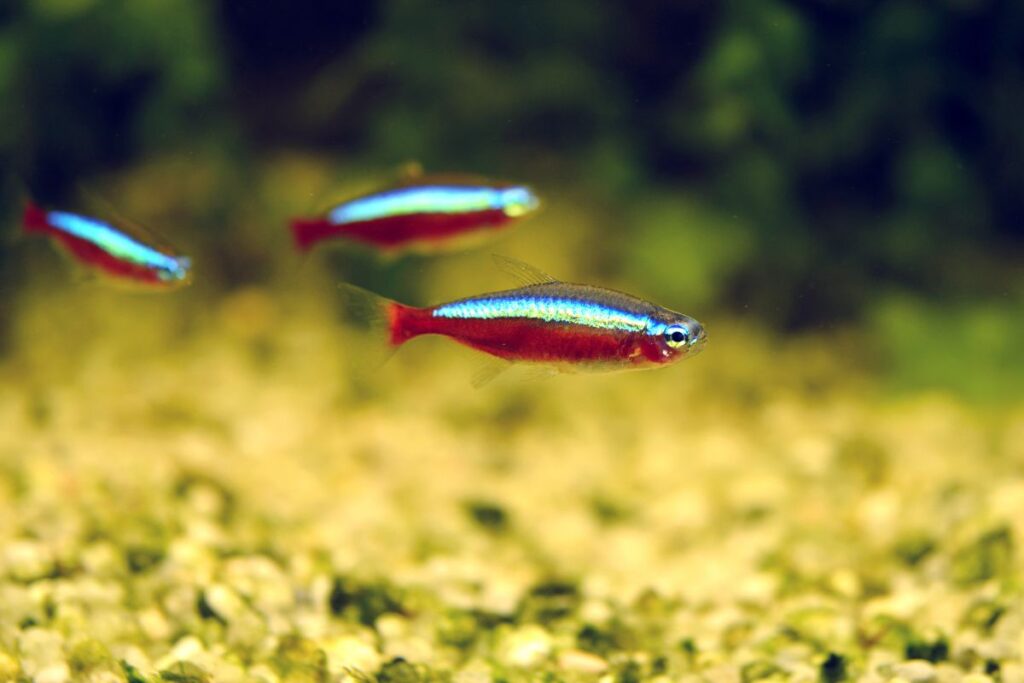
Aquarium Size
When it comes to cardinal tetra, the bigger the aquarium, the better. Aim for a minimum of 10 gallons, but if you can afford a larger tank, go for it.
A larger tank will not only provide more swimming space for your tetras, but it will also make it easier to maintain water quality.
Lighting
Cardinal tetras prefer dim lighting, so avoid bright lights that can cause stress. Use a low-wattage bulb or install a dimmer switch to control the brightness of your aquarium lights.
Filtration
A good filtration system is essential for the health of your cardinal tetras. Choose a filter that is appropriate for the size of your tank and make sure to clean it regularly to keep the water clean and clear.
Aeration
Cardinal tetras require a well-oxygenated environment, so make sure to install an air pump or a filter that provides enough aeration to keep the water oxygenated.
Heater
Cardinal tetras are tropical fish and require a water temperature between 75-82°F. Install a heater to maintain a consistent water temperature in your aquarium.
Substrate
Choose a fine-grained substrate, such as sand or gravel, that won’t harm the delicate fins of your cardinal tetras. Avoid sharp or rough substrates that can cause injury.
Plants and Decorations
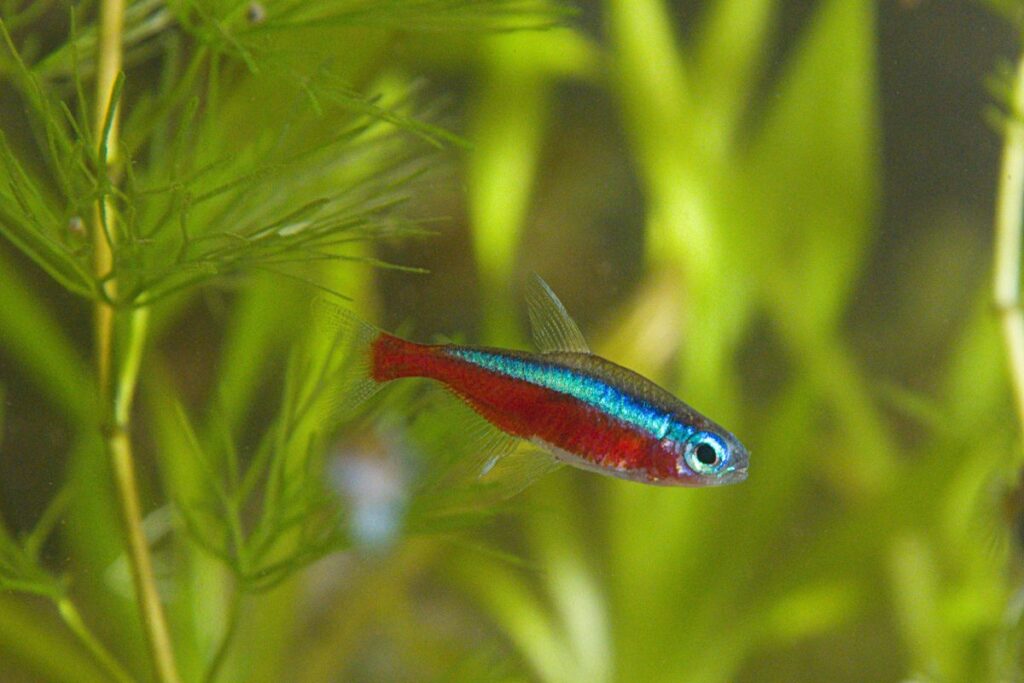
Cardinal tetras love to hide among plants and decorations, so make sure to provide plenty of hiding spaces in your aquarium.
Live plants are a great option, as they also help to maintain water quality. Avoid sharp or rough decorations that can cause injury to your tetras.
Personally, I have found that adding a few floating plants, such as Amazon frogbit, not only provides additional hiding spaces but also helps to diffuse the light and create a more natural environment for my cardinal tetras.
Water Parameters
Temperature
The cardinal tetra is a tropical fish and requires a stable water temperature between 75-82 degrees Fahrenheit.
I have found that maintaining a temperature of 78 degrees Fahrenheit works best for my cardinal tetras.
pH
The cardinal tetra prefers a slightly acidic water with a pH between 5.0-7.0. I recommend keeping the pH around 6.5 for optimal health and coloration.
Hardness
Cardinal tetras prefer soft to slightly hard water with a hardness level between 1-8 dGH. I have found that a hardness level of 4 dGH works best for my cardinal tetras.
Ammonia, Nitrite, and Nitrate
It is important to monitor the levels of ammonia, nitrite, and nitrate in the aquarium water regularly. High levels of these compounds can be toxic to cardinal tetras and cause health problems.
I recommend keeping ammonia and nitrite levels at 0 ppm and nitrate levels below 20 ppm.
To maintain optimal water parameters, perform regular water changes of 25% to 50% every week. Use a reliable water test kit to monitor the water parameters and adjust the levels as necessary.
Adding a high-quality aquarium salt can also help to maintain stable water parameters and promote overall health and well-being of your cardinal tetras.
Remember, maintaining stable and optimal water parameters is crucial to the health and well-being of your cardinal tetras.
By monitoring and adjusting the water temperature, pH, hardness, and levels of ammonia, nitrite, and nitrate, you can ensure that your cardinal tetras thrive in their aquarium environment.
One time, I neglected to monitor the water parameters in my aquarium, and my cardinal tetras became lethargic and lost their vibrant coloration.
After performing a water change and adjusting the water parameters, they gradually regained their health and coloration.
It was a lesson learned, and I now make sure to monitor the water parameters regularly to keep my cardinal tetras happy and healthy.
Maintenance
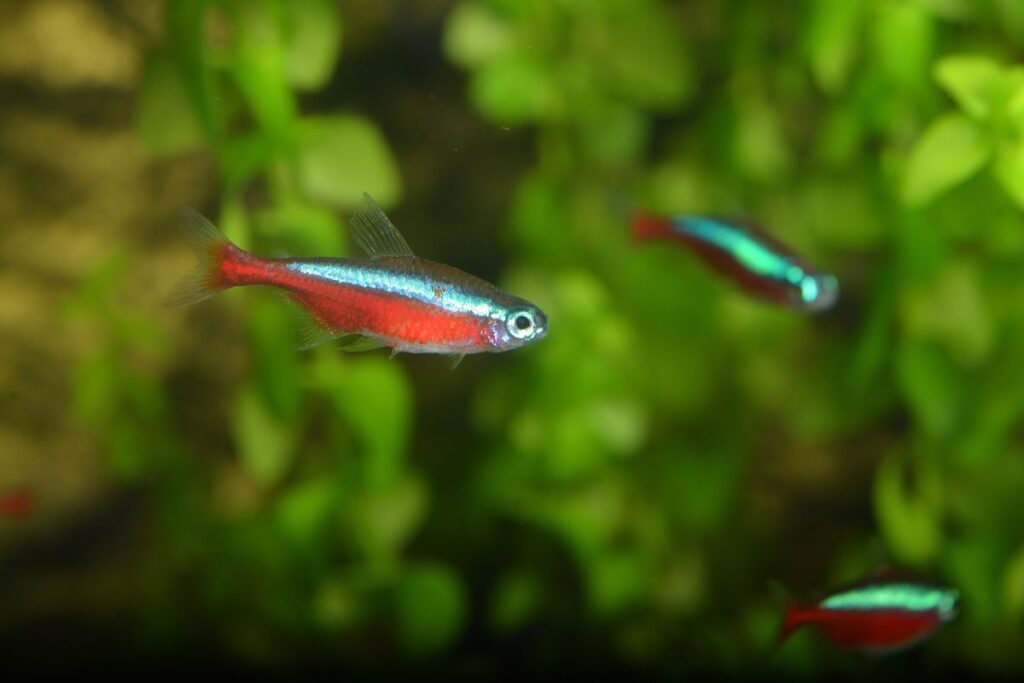
Keeping cardinal tetras healthy and happy requires regular maintenance. In this section, we’ll cover the essential tasks that should be performed to maintain a clean and stable environment for your fish.
Water Changes
Regular water changes are critical to maintaining a healthy environment for your cardinal tetras. I recommend changing 20% of the water in your aquarium every week.
This will help remove any accumulated waste and keep the water chemistry stable.
When performing a water change, be sure to use a water conditioner to remove any chlorine or chloramines from your tap water.
Also, make sure the water temperature matches the temperature in your aquarium to avoid shocking your fish.
Cleaning
Regular cleaning of your aquarium is essential to prevent the buildup of harmful bacteria and other contaminants. I recommend cleaning your aquarium every two weeks.
During cleaning, remove any uneaten food, dead plant matter, and other debris from the bottom of the tank. Use an aquarium vacuum to remove any waste that has settled on the substrate.
You should also clean the filter every month. Rinse the filter media in a bucket of aquarium water to remove any debris, and replace any worn or damaged media.
Testing Water Parameters
Regular testing of your aquarium water is essential to maintaining a stable and healthy environment for your fish. I recommend testing your water every week to monitor for any changes in water chemistry.
You should test for ammonia, nitrite, nitrate, pH, and water hardness. Use a reliable test kit to ensure accurate results.
Disease Prevention
Preventing disease is much easier than treating it. You can reduce the risk of disease by maintaining a clean and stable environment for your cardinal tetras.
Make sure to quarantine any new fish before adding them to your aquarium. This will help prevent the introduction of any diseases or parasites.
Also, avoid overfeeding your fish, as this can lead to a buildup of waste and increase the risk of disease. Finally, be sure to observe your fish regularly for any signs of illness, such as lethargy, loss of appetite, or abnormal behavior.
By following these maintenance tips, you can help ensure that your cardinal tetras remain healthy and happy for years to come.
Personally, I have found that regular maintenance is the key to keeping my cardinal tetras healthy and thriving.
By performing regular water changes, cleaning, and testing, I have been able to maintain a stable environment for my fish.
I have also been able to prevent disease by quarantining new fish and observing my fish regularly for any signs of illness.
Tank Mates for Cardinal Tetra
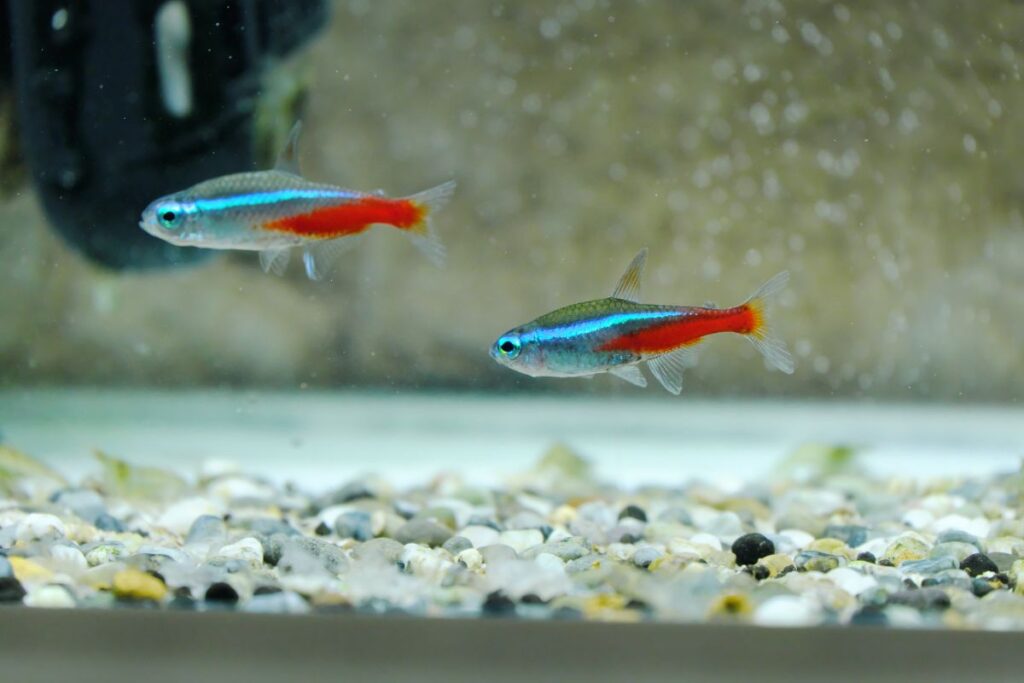
Choosing the right tank mates for your cardinal tetra is crucial to ensure their safety and well-being.
Cardinal tetras are peaceful and non-aggressive, making them a great addition to community tanks. However, there are some species that may not be compatible with them.
Personally, I have had success keeping cardinal tetras with other small, peaceful fish such as neon tetras, guppies, and otocinclus catfish.
These species are all relatively small and non-aggressive, making them great companions for cardinal tetras.
It is important to avoid keeping cardinal tetras with larger or more aggressive fish, as they may become targets for bullying or even become a snack. Avoid species such as cichlids, angelfish, and bettas.
When introducing new tank mates to your cardinal tetras, it is important to monitor their behavior closely. If you notice any signs of aggression or stress, it may be necessary to separate them.
In summary, choose tank mates that are small, peaceful, and non-aggressive when keeping cardinal tetras. Always monitor their behavior closely and be prepared to separate them if necessary.
How Many Cardinal Tetras Should be Kept Together?
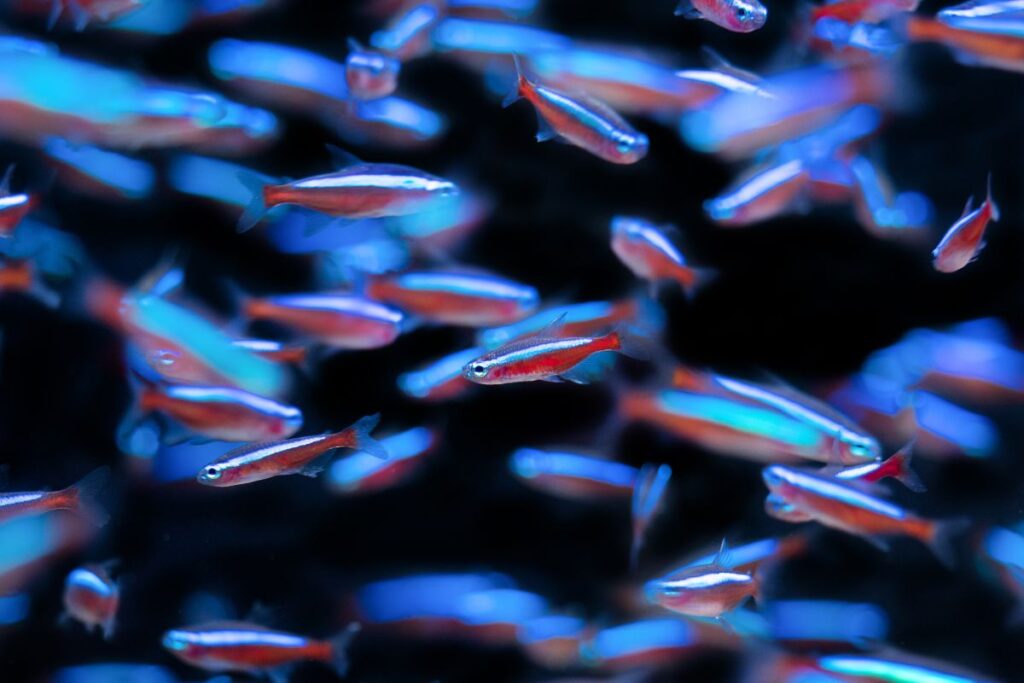
Cardinal tetras are a shoaling fish, which means they are social creatures that enjoy living in groups. They feel more secure and comfortable when they are surrounded by their own kind.
Therefore, it is recommended to keep at least 6 cardinal tetras together in a tank. However, keeping more than 6 tetras is always better.
Personally, I have found that keeping a group of 10-12 cardinal tetras together in a 20-gallon tank works great. It allows them to swim around freely and form a tight shoal.
When I first started keeping cardinal tetras, I made the mistake of keeping only 3 of them together. They looked lonely and stressed, and their colors were not as vibrant as they should be.
As soon as I added more tetras to the tank, they became more active and colorful.
It is important to note that cardinal tetras are small fish and do not take up much space. Therefore, it is possible to keep a larger group of them together in a tank without overcrowding it.
However, it is important to maintain good water quality and provide enough hiding places for them to feel safe.
Overall, keeping a group of 6-12 cardinal tetras together is ideal.
It allows them to exhibit their natural behavior and show off their vibrant colors. Just remember to provide them with a suitable environment and they will thrive in your tank.
Feeding
Diet
Cardinal tetras are omnivores and eat a variety of foods in the wild, including small insects, crustaceans, and plant matter.
In captivity, they can be fed a diet of high-quality flake or pellet food, supplemented with live or frozen foods such as brine shrimp, bloodworms, and daphnia.
It’s important to provide a varied diet to ensure that your tetras receive all the necessary nutrients.
Personally, I have found that my cardinal tetras love live food the most, and I try to provide them with some every few days. Seeing them chase after and devour live food is a joy to watch!
Feeding Schedule
Cardinal tetras should be fed small amounts of food two to three times a day. Overfeeding can lead to health problems and pollute the aquarium water.
A good rule of thumb is to feed only what your tetras can consume in two to three minutes.
If there is leftover food after this time, remove it from the aquarium to prevent it from decomposing and causing water quality issues.
I personally feed my tetras twice a day, once in the morning and once in the evening. This schedule has worked well for me and my fish seem to be healthy and happy.
Overall, feeding your cardinal tetras a varied diet and sticking to a consistent feeding schedule will help keep them healthy and happy in your aquarium.
Common Diseases
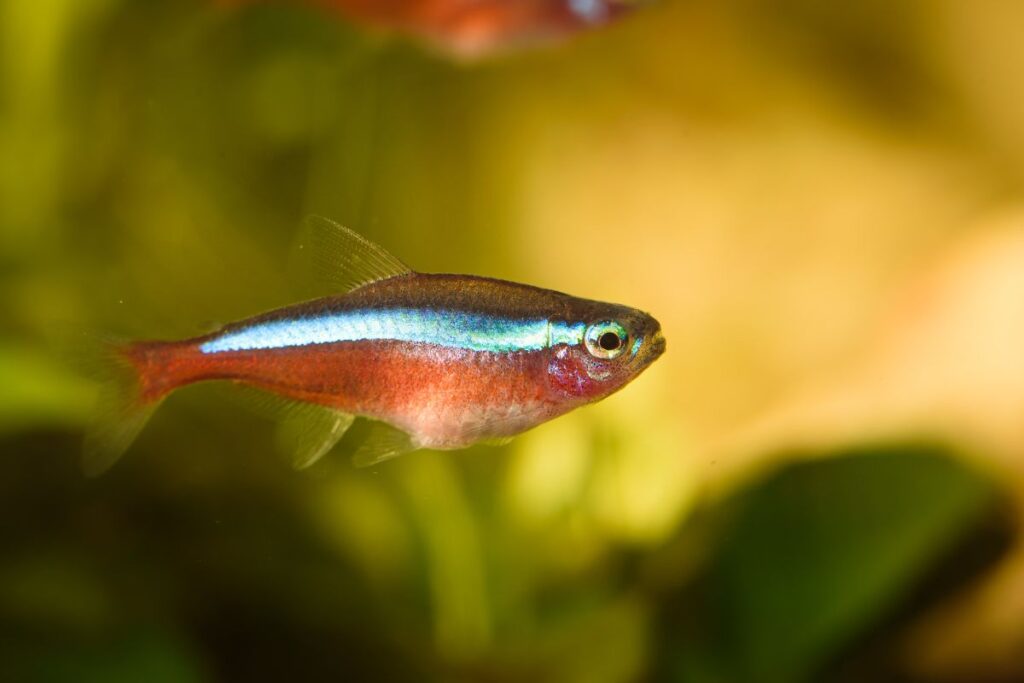
Signs
Cardinal tetras are prone to several diseases that can be identified by certain signs. The most common signs of disease in cardinal tetras include:
- Loss of appetite
- Abnormal swimming behavior
- Discoloration
- Swollen abdomen
- White spots on the body
Causes
There are several factors that can cause diseases in cardinal tetras. Some of the common causes include:
- Poor water quality
- Overfeeding
- Stress
- Introduction of new fish
- Parasites
Treatment
If you notice any signs of disease in your cardinal tetras, it is important to take action immediately to prevent the spread of the disease.
Here are some steps you can take:
- Quarantine the affected fish in a separate tank
- Perform a water change to improve water quality
- Adjust the temperature and pH level of the water
- Administer medication as recommended by a veterinarian or fish expert
Personally, I have had to deal with a case of ich in my cardinal tetras. I noticed white spots on their bodies and knew that it was a sign of the disease.
I immediately quarantined the affected fish in a separate tank and administered medication as recommended by a fish expert.
With proper care and treatment, my cardinal tetras were able to recover and thrive once again.
Signs of Healthy Cardinal Tetra
It’s important to keep an eye on your cardinal tetra’s health to ensure they’re happy and thriving in their environment.
Here are some signs to look out for:
- Bright and vibrant coloration: Cardinal tetras should have a deep red coloration on their body and a bright blue stripe running down their sides. If their colors are dull or faded, it could be a sign of stress or illness.
- Active and energetic behavior: Healthy cardinal tetras should be swimming actively and exploring their tank. If they’re lethargic or hiding in the corners, it could be a sign of stress or illness.
- Clear and alert eyes: Cardinal tetras should have clear and bright eyes. If their eyes are cloudy or sunken, it could be a sign of illness.
- Healthy fins: Cardinal tetras should have intact and undamaged fins. If their fins are torn or ragged, it could be a sign of aggression from other fish in the tank.
Personally, I’ve found that observing my cardinal tetras during feeding time is a great way to gauge their health.
If they’re eagerly swimming to the surface to eat and chasing after the food, it’s a good sign that they’re healthy and happy.
Remember, maintaining a healthy environment with proper water parameters and a balanced diet is key to ensuring your cardinal tetras stay healthy and happy.
Signs of Sick Cardinal Tetra
As a pet owner, it is important to be able to identify the signs of a sick cardinal tetra. Early detection can prevent the spread of disease and increase the chances of recovery.
Here are some common signs to look out for:
- Loss of appetite
- Unusual swimming behavior
- Discoloration
- Clamped fins
- Gasping for air at the surface of the water
- Lethargy
If you notice any of these signs, it is important to take action immediately. The first step is to isolate the sick fish from the rest of the tank to prevent the spread of disease. You should also test the water quality to ensure that the tank is not the source of the problem.
When I first started keeping cardinal tetras, I noticed that one of my fish was swimming erratically and had clamped fins. I immediately isolated the fish and tested the water quality. It turned out that the pH level was too low, which was causing stress to the fish. After adjusting the pH level and providing some extra care, the fish made a full recovery.
Remember, prevention is key when it comes to keeping your cardinal tetras healthy. Regular water changes, a balanced diet, and a clean tank can go a long way in preventing illness. However, if you do notice any signs of sickness, don’t hesitate to take action and seek advice from a veterinarian or experienced fish keeper.
Breeding
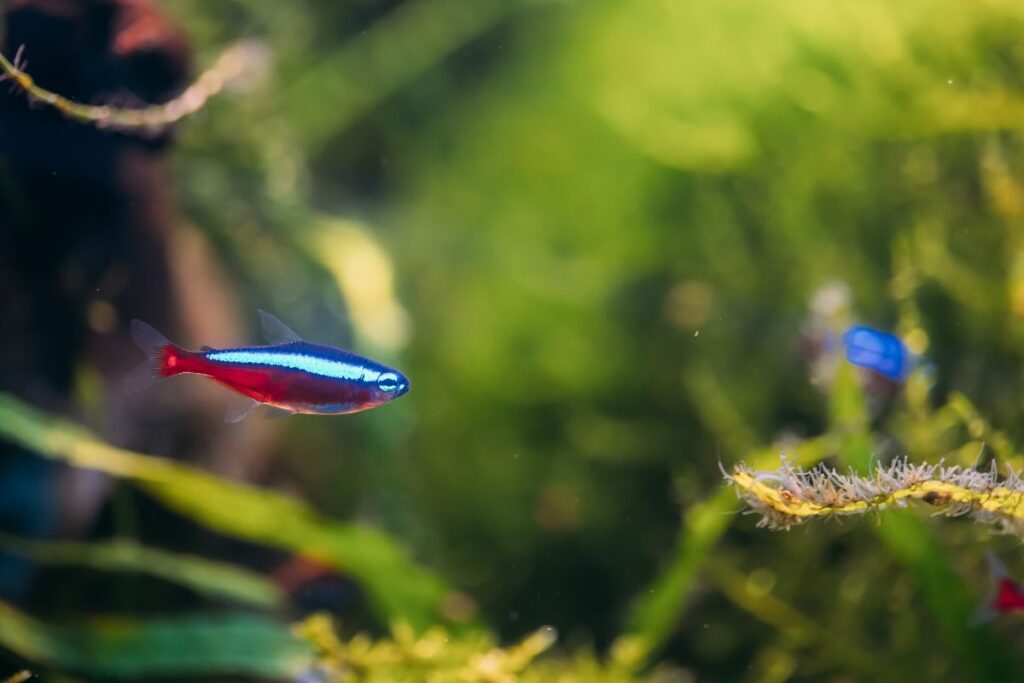
Breeding cardinal tetras can be a rewarding experience for any aquarist. However, it is important to note that it can be a challenging process that requires time and effort.
Here are some tips on how to successfully breed cardinal tetras.
Breeding Setup
To begin breeding cardinal tetras, you will need to set up a breeding tank. The breeding tank should be at least 10 gallons in size and should have a sponge filter to provide gentle filtration.
The water in the breeding tank should be soft and slightly acidic, with a pH between 5.5 and 6.5. To encourage breeding, you should also add some breeding mops or spawning mops to the tank.
These mops can be made from yarn or other materials and will provide a suitable surface for the tetras to lay their eggs on.
Breeding Process
Once your breeding tank is set up, you can introduce your breeding pair of cardinal tetras.
It is important to note that cardinal tetras are egg scatterers, meaning that they will scatter their eggs throughout the tank rather than laying them in a specific location.
To encourage breeding, you should provide your tetras with a well-balanced diet that includes live or frozen foods.
You can also try lowering the water level in the breeding tank to simulate the rainy season, which is when cardinal tetras typically breed in the wild.
After breeding, the adult tetras should be removed from the breeding tank to prevent them from eating the eggs or fry.
The eggs will hatch in about 24 hours, and the fry will become free-swimming after about 3-4 days. At this point, you can begin feeding the fry with newly hatched brine shrimp or other small foods.
Personally, I found that breeding cardinal tetras requires patience and dedication. It took me several attempts to successfully breed my tetras, but the experience was well worth it.
Seeing the tiny fry swimming around in the tank was truly a rewarding experience.
Product Recommendation:
- Fluval Plant and Shrimp Stratum – This substrate is specifically designed for planted aquariums and can provide a natural environment for your cardinal tetras. It also contains nutrients that can help to promote plant growth.
- Marineland Penguin Power Filter – This filter is appropriate for a 20-gallon aquarium and can handle the bioload of cardinal tetras. It also has a bio-wheel that provides biological filtration and helps to maintain water quality.
- Finnex Planted+ 24/7 LED Aquarium Light – This light provides a customizable lighting schedule that can simulate sunrise, sunset, and moonlight. It is also energy-efficient and can help to promote plant growth in your aquarium.
- API Freshwater Master Test Kit – This test kit can help you monitor the levels of ammonia, nitrite, nitrate, pH, and hardness in your aquarium water. It is important to test your water regularly to ensure that it is within safe ranges for your cardinal tetras.
- Seachem Prime – This water conditioner can help to detoxify ammonia, nitrite, and nitrate, making it safe for your cardinal tetras. It can also help to promote a healthy slime coat and reduce stress in your fish.
- TetraMin Tropical Flakes – This is a staple food for tropical fish, including cardinal tetras. It contains a balanced mix of nutrients, vitamins, and minerals that can help to promote overall health and well-being.
- Hikari Micro Pellets – These small pellets are specifically designed for small-mouthed fish like cardinal tetras. They are high in protein and can help to promote growth and coloration.
Conclusion
After reading this ultimate care guide, you should have a good understanding of how to care for your cardinal tetra. Remember to keep the water clean and stable, provide a balanced diet, and create a suitable environment for your fish.
Personally, I have found cardinal tetras to be a joy to care for. Their vibrant colors and active personalities make them a great addition to any aquarium. However, it’s important to remember that they are living creatures that require proper care and attention.
By following the tips outlined in this guide, you can ensure that your cardinal tetras thrive in their home. Remember to always do your research and consult with a veterinarian or experienced aquarist if you have any questions or concerns.
Thank you for taking the time to read this guide. We hope that it has been informative and helpful in caring for your cardinal tetra. Happy fishkeeping!
FAQs
As you start caring for your cardinal tetra, you may have some questions. Below are answers to some of the most frequently asked questions about cardinal tetra care:
Q: How often should I feed my cardinal tetra?
A: Personally, I feed my cardinal tetras twice a day, once in the morning and once in the evening. However, you can feed them once a day if you prefer. Just make sure to only give them as much food as they can eat in a few minutes, and avoid overfeeding.
Q: What type of food should I feed my cardinal tetra?
A: Cardinal tetras are omnivores, so they will eat both meaty and plant-based foods. I recommend feeding them a variety of high-quality flake, pellet, and frozen foods. Make sure to also include some vegetable matter in their diet, such as spirulina flakes or blanched vegetables.
Q: How often should I change the water in my cardinal tetra tank?
A: It is recommended to do a partial water change of 25-50% every week. This will help maintain good water quality and keep your cardinal tetras healthy.
Q: Can I keep cardinal tetras with other fish?
A: Yes, cardinal tetras are peaceful fish and can be kept with other small, peaceful fish. Just make sure to avoid keeping them with any aggressive or fin-nipping fish.
Q: How many cardinal tetras should I keep in my tank?
A: A good rule of thumb is to keep at least six cardinal tetras in a tank. However, they can also be kept in larger groups of 10 or more, which can create a stunning visual display.
By following these guidelines and providing proper care, your cardinal tetras will thrive in your aquarium and bring you joy for years to come.
Reference: Wikipedia.
